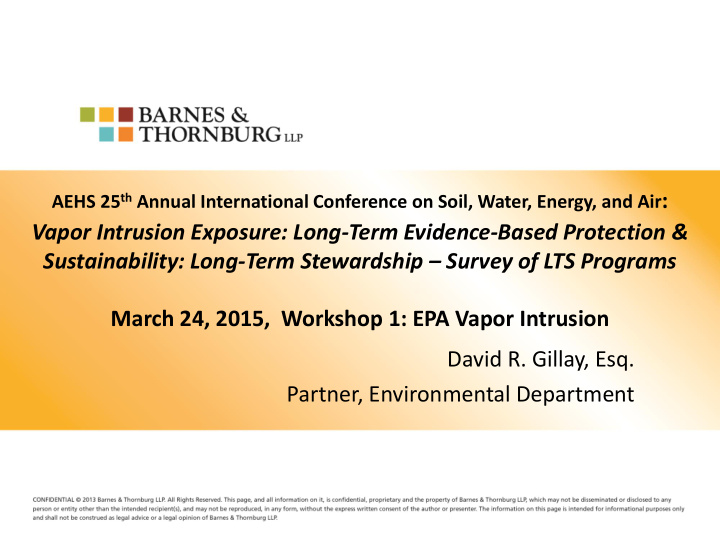



AEHS 25 th Annual International Conference on Soil, Water, Energy, and Air : Vapor Intrusion Exposure: Long-Term Evidence-Based Protection & Sustainability: Long-Term Stewardship – Survey of LTS Programs March 24, 2015, Workshop 1: EPA Vapor Intrusion David R. Gillay, Esq. Partner, Environmental Department
Setting the Stage • Draconian Liability Schemes • Birth of new due diligence standard & continuing obligations to maintain LLPs • VI Evolution • TCE Revolution • Re-opening of closed sites • Long Term Stewardship Revelation – State & Federal Survey
Re-Opening Triggers • New National Guidance for 5-YR Reviews – Superfund Sites • State regulatory scrutiny on TCE and VI – CA, MN, NY, NJ, CT • Litigation trends and update – Transactional issues – Environmental Consulting Firms
Transactions & Redevelopment Continuing Obligations • EPA origins: 2002 Brownfield Amendments and new Bona Fide Prospective Purchaser Defense (BFPP) • BFPP defense allows you to purchase known contaminated property and avoid CERCLA liability provided certain pre and post requirements are satisfied. • Focus here is on post-Closing.
Continuing Obligations – Provide access to those conducting response actions [AND] – Take reasonable steps to: (a) stop any continuing release (b) prevent any future threatened release; and (c)prevent or limit any human, environmental, or natural resource exposure to any previously released hazardous substance • What does this really mean?
Continuing Obligations
LTS Revelation • In most States, ICs are generally necessary unless the site meets unlimited use and unrestricted exposure (UU/UE) (i.e ., Generic Residential Clean-up). • Regulatory cleanup levels for UU/UE are virtually impracticable to achieve (TCE, cPNAs) – Off-site issues can complicate pathway to closure • The more contamination that is left, the longer your tail of post-closure obligations will be, which will potentially increase liability and “taint” real estate.
Federal IC Policy • EPA’s National Policy on Use and Roles of ICs is to develop an IC Plan : – Institutional Controls: A Guide to Planning, Implementing, Maintaining, and Enforcing Institutional Controls at Contaminated Sites , EPA- 540-R-09- 001 (Dec. 2012) [referred to as the “ IC Guidance ”] – Institutional Control: A Guide to Preparing Institutional Control Implementation and Assurance Plans at Contaminated Sites , EPA-540-R-09-002 (Dec. 2012) [referred to as “ICIAP Guidance” or “IC Plan” ]
IC Guidance – Key Takeaways • EPA recommends the balancing criteria required under CERCLA and the NCP and recommended by RCRA. • Consider a matrix to transparently show evaluation. Critically review. • Key criteria: – Long-term effectiveness – consider size of area to be managed, the COIs, characterization/plume behavior, who will monitor and enforce. – Costs – estimate costs for implementing, monitoring, and enforcing ICs.
National Guidance • Long-Term Stewardship Studies & Initiatives [www.epa.gov/landrevitalization/ltstf_report/appendixb.htm ] – U.S. DOE – Long Term Stewardship Planning Guidance for Closure Sites – National Association of Attorneys General (NAAG) on Legal Handbook of Institutional Controls – Association of State & Territorial Solid Waste Mgmt Officials (ASTSWMO) – Interstate Technology & Regulatory Council (ITRC) – Issues of Long Term Stewardship: State Regulators’ Perspectives (2004 + 2014/5 update)
Florida • FDEP – Division of Waste Mgmt [Nov. 2013] • The use of ICs to eliminate or control potential exposure to residual contamination – Site Rehabilitation Completion Order with Conditions] • Engineering Control Maintenance Plan (ECMP) – inspect, monitor, and maintain • Interim ICs option to promote redevelopment • IC Control on Non-Source Property • IC Registry • Templates, Notices, RCs
Missouri • MDNR consolidated LTS in 2012 to ensure that LTS sites are properly managed (10,000 sites) • ICs are viable risk management tool IF they are durable, enforceable and run with the land • Decision-makers should weight full costs of long term S&A with potential long-term risks • Missouri Long Term Stewardship : Current Practices & Future Recommendations – Define a common threshold for LTS – LTS monitoring and audit program – LTS Fees on an annual basis
New York • NYS DEC – Division of Environmental Remediation • Template for a Site Management Plan [Feb. 2013] – Engineering & Institutional Control for I/M of EC/ICs – Monitoring Plan for Site Monitoring – Operation and Maintenance • Periodic review (at least annually) • CSM is key • Responsibilities
Wisconsin • WI DNR through its Remediation & Redevelopment Program – Continuing Obligations for Environmental Protection [Nov. 2013] • WI, like most states, allows some contamination to remain after cleanup of soil or groundwater (residual contamination) • DNR Registry with continuing obligations • New Forms and Process
Questions or Comments David R. Gillay, Esq. Chair, Environmental Transactional Diligence Co-Chair, Redevelopment & Remediation (317) 231-7474 or (317) 946-9267 david.gillay@btlaw.com
Recommend
More recommend